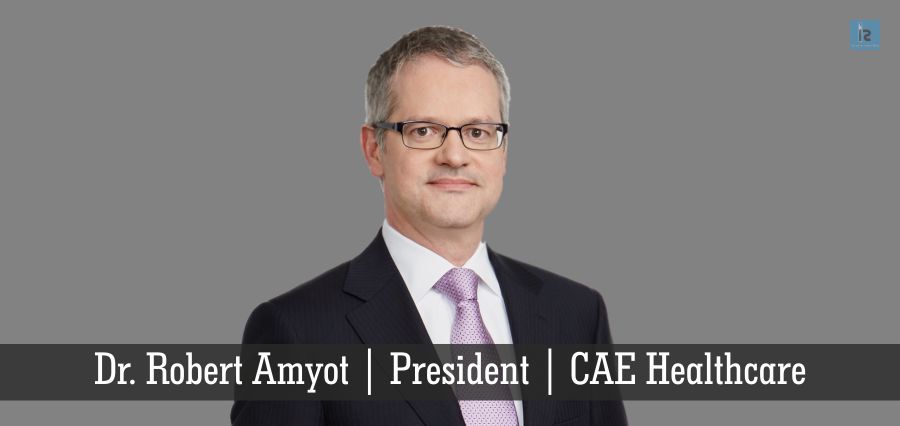In an interview with Insights Success, Dr. Robert Amyot, President of CAE Healthcare, shares his experience and gives resourceful insights. In addition, he emphasizes the CAE Healthcare mission and its products along with the future goals in revolutionizing the industry.
Below are the highlights of the interview conducted between Dr. Amyot and Insights Success:
Give a brief overview of the company, its uniqueness and its vision.
CAE Healthcare offers a cutting-edge learning environment to healthcare students and professionals where they develop practical experience before treating real patients. CAE Healthcare is transferring the expertise, technologies and best practices of high-reliability organizations like commercial aviation to healthcare.
What are the cutting-edge products/solutions offered by CAE Healthcare?
CAE Healthcare offers the most extensive portfolio of simulation products and services for all the healthcare disciplines, with patient, ultrasound and surgical simulators as well as center management and faculty-developed curriculum. Today, approximately 13,500 CAE Healthcare simulators and audiovisual solutions are in use in over 80 countries worldwide by medical schools, nursing schools, hospitals, defense forces and other entities.
One of the most recent examples of our leadership in innovation is CAE LucinaAR, our high-fidelity childbirth simulator with augmented reality. Equipped with the Microsoft HoloLens, the simulator projects a hologram of the fetus as it descends the birth canal: this unique integration of augmented reality with our realistic patient simulator physiology allows students to see how their actions and maneuvers affect the baby and the mother. CAE LucinaAR with HoloLens offers training for rare but threatening complications of childbirth, like shoulder dystocia and hemorrhage, in which the delivery team must act quickly to prevent injury and mortality. It can save lives: experts estimated that worldwide, more than 140,000 mothers die each year during delivery from postpartum hemorrhaging, and that 75% of these deaths could have been prevented.
CAE Healthcare also offers peer-to-peer training of faculty who are learning to teach with simulation. The CAE Healthcare Academy has developed more than 500 simulation scenarios and training courses for educators, including a simulation fellowship with the International Nursing Association for Clinical Simulation & Learning (INACSL).
Give a detailed description of your influence over the company and the simulation solutions.
I am a cardiologist and clinician-researcher by trade, but an entrepreneur at heart. I lead CAE Healthcare with a clear mission: to improve patient safety and healthcare training through simulation-based education.
Before joining CAE, I founded a startup that developed the Vimedix ultrasound simulator and following several years as an entrepreneur, I sold my company to CAE Healthcare and eventually became President. When meeting with leading healthcare providers, medical societies and scientific associations, I share the message that simulation-based training and ongoing competency assessment for clinicians promotes improved patient safety.
Describe the experiences, achievements or lessons learnt that have shaped the journey of the company.
Simulation is a relatively new approach in healthcare and it has required advocacy on the part of the clinical faculty and instructors. CAE Healthcare’s Human Patient Simulation Network (HPSN) conferences have been vital in shaping and advancing the practice by bringing together a passionate and global network of educators.
We partner with medical societies and governments to offer turnkey solutions: for example, we collaborate with the American Heart Association to open international training sites within CAE training centers around the world. We also partnered with the American Society of Anesthesiologists to develop a virtual operating room with an interactive patient for maintenance of certification courses for practicing physicians.
What are the challenges faced while providing simulation solutions and how is CAE Healthcare serving to tackle them?
One of the challenges is learning how to integrate simulation into an already full curriculum, or into a hospital setting to allow clinical teams to practice code blues and other emergency responses. The CAE Healthcare Academy supports all users of simulation with curriculum that is validated and easy to use, with onsite training, and with peer-to-peer support.
What according to you could be the potential future of simulation solutions and how does CAE Healthcare envision sustaining its competency?
Simulation will become a central element in training and more present in a growing movement towards high stakes assessment and certification for all disciplines in healthcare. Simulation will also expand beyond the students and become relevant for all healthcare professionals. In an effort to shift to value-based care, hospitals are increasingly given incentives to become safer and more efficient which will drive higher demand for more effective training.
Today’s generation of healthcare learners expects an engaging, interactive environment: CAE Healthcare will continue to lead with innovations and advanced solutions for the education and certification of students and professionals in all the healthcare disciplines.
Testimonials from CAE Healthcare Clients
“The realism of CAE manikins provides students the opportunity to critically think during simulation.” – Donna Hatch, MSN, RN, Academic Dean of Nursing, Collin College, USA
“LearningSpace is a system that can grow with the organization, enriching both the student journey and faculty management of educational activities.” – Ann Sunderland, Director of Clinical Skills and Simulation, Leeds Beckett University, UK
Source: The 10 Most Trusted Simulation Solution Providers 2018

CAE Healthcare

